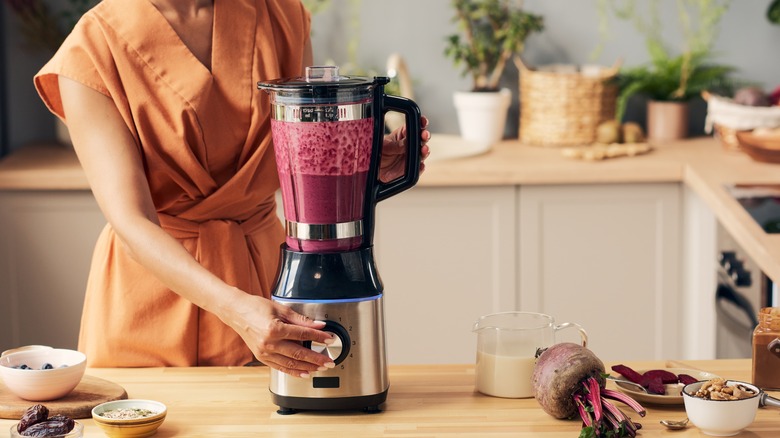Why You Should Never Mix Hot Liquid In A Blender
Believe it or not, blenders just recently turned 100 years old. According to Interesting Engineering, in 1922, Stephen Poplawski added spinning blades to the bottom of a glass pitcher, creating the first official blender. Of course, before that, purees were probably done with a mortar and pestle. Without Poplawski's innovation, a breakfast smoothie would be pretty difficult to make.
In the past century, the basics of blenders haven't changed too much. That pitcher with blades at the bottom sits atop an electric motor that spins the blades. What has changed is how much we use a blender. Per Globe Newswire, global blender sales in 2021 reached $2.57 billion. As millennials overtake baby boomers as the largest generation, that number is going to grow to as much as $3.58 billion by 2028.
As blenders become a kitchen appliance must-have, it's worth reminding those consumers that blending can be tricky, if not downright dangerous. Blenders have become incredibly powerful, so much so that blender manufacturer Blendtec's YouTube channel celebrates blending just about everything. It's safe to say, don't try any of that at home. Blenders can explode when they're filled with something as innocuous as soup.
How to safely blend hot liquids
According to Food Network, blending hot food is something that can really damage your kitchen. Or, more importantly, damage the cook using the blender. As those hot liquids are blended, they expand. That, and the pressure of some steam can be enough to push the lid of the blender off, spewing hot liquid across the kitchen. So, savvy cooks know to remove the lid, or the removable section of the lid and hold a kitchen towel over the opening. That will allow the pressure to escape safely.
That kitchen towel hack works, but there's still not much between the hot liquid and the hand holding the towel. So, there are other steps to really ensure safe blending, per Blender Adviser. Taking food straight from the burner to the blender will maximize the amount of steam to deal with. More steam means more pressure and a higher likelihood of burns. So, let the food rest, off the heat, for three to five minutes. There may still be some steam. To keep that off of you, it is recommended that you open the lid away from you. Slower speeds will keep things in the blender, too. Start slow and increase the speed gradually.
Finally, KitchenAid asks users to heed the max fill lines on the blender jars. These levels might be lower than you'd expect. That's especially true for hot liquids, but it's better to safely blend two batches, than cram all of it into one blender jar that ends up all over your kitchen.
Are there other blender nevers?
Blenders are so commonplace now, they can be taken for granted. Maybe we should all take a minute and consider what we should and shouldn't do in our blenders. Afterall, even if you have the best blenders for smoothie making, there's more to it than loading up the jar and hitting start. Even for something as simple as a smoothie, there's a guide for how to load your blender when making a smoothie.
Aside from hot foods, Compact Appliance identifies another half dozen foods that don't belong in a blender. Doughs and cooked potatoes are too "thick and gooey" for blenders. These can overload the motor which will shorten the lifespan of the blender, or even risk an electrical fire. Sticky foods, like dried fruit, are the same, unless they've been rehydrated to soften. Even then, it's best to blend them with plenty of liquid.
Whole spices or coffee beans are hard on anything but the brawniest blenders. Ditto for ice cubes. It's best to start with crushed ice. Frozen foods should thaw slightly to soften. Fibrous foods, like broccoli, should be cooked prior to blending.
Finally, and hopefully most obviously, don't put anything, like a spoon or a spatula, into the blender jar while it's running. It's tempting to poke around into the blender to get things moving, but remove the jar from the blender before doing this. A dropped spoon will damage the blades, the jar, or yourself.


